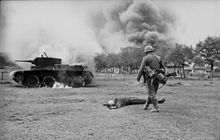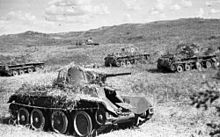BT series
| BT-2 | |
|---|---|

BT-2 |
|
| General properties | |
| crew | 3 (commander / radio operator, driver, gunner) |
| length | 5.35 m |
| width | 2.23 m |
| height | 2.20 m |
| Dimensions | 10.2 tons |
| Armor and armament | |
| Armor | 6-13 mm |
| Main armament | 37 mm Model 30; 96 shells |
| Secondary armament | 1 × coaxial MG DT |
| agility | |
| drive | M-5 petrol engine 400 hp |
| suspension | Christie suspension |
| Top speed | 72 km / h (on wheels) and 52 km / h (on chains) |
| Power / weight | 39.00 hp / ton |
| Range | 300 km (road) and 100 km (terrain) |
| BT-5 | |
|---|---|

BT-5 |
|
| General properties | |
| crew | 3 (commander / radio operator, driver, gunner) |
| length | 5.35 m |
| width | 2.23 m |
| height | 2.20 m |
| Dimensions | 11.5 tons |
| Armor and armament | |
| Armor | 6-13 mm |
| Main armament | 45 mm mod. 32 L / 46; 72-115 shells |
| Secondary armament | 1 × coaxial MG DT ; 2709 cartridges |
| agility | |
| drive | M-5 petrol engine 400 hp |
| suspension | Christie suspension |
| Top speed | 72 km / h (on wheels) and 52 km / h (on chains) |
| Power / weight | 34.78 hp / ton |
| Range | 200 km (road) and 90 km (terrain) |
| BT-7 | |
|---|---|

BT-7 |
|
| General properties | |
| crew | 3 (commander / radio operator, driver, gunner) |
| length | 5.66 m |
| width | 2.23 m |
| height | 2.42 m |
| Dimensions | 13.8 tons |
| Armor and armament | |
| Armor | 6-22 mm |
| Main armament | 45 mm Mod. 34 L / 46; 132-146 shells |
| Secondary armament | 1 × coaxial MG DT , 1 × Fla-MG DT; 2394 cartridges |
| agility | |
| drive |
Mikulin M-17 T petrol engine 400–500 hp |
| suspension | Christie suspension |
| Top speed | 72 km / h (on wheels) and 52 km / h (on chains) |
| Power / weight | 34.78-36.23 hp / ton |
| Range | 250 km (road) and 120 km (terrain) |
| BT-7A (BT-7Art.) | |
|---|---|

BT-7A |
|
| General properties | |
| crew | 3 (commander / radio operator, driver, gunner) |
| length | 5.66 m |
| width | 2.29 m |
| height | 2.42 m |
| Dimensions | 14.0 tons |
| Armor and armament | |
| Armor | 6-22 mm |
| Main armament | 76.2 mm gun KT-28 |
| Secondary armament | 2 × coaxial MG DT (front / rear), 1 × Fla-MG DT |
| agility | |
| drive | Mikulin M-15T / Mikulin M-17 T petrol engine 400-500 hp |
| suspension | Christie suspension |
| Top speed | 72 km / h (on wheels) and 50 km / h (on chains) |
| Power / weight | 34.78-36.23 hp / ton |
| Range | 250 km (road) and 120 km (terrain) |
| BT-7M (BT-8) | |
|---|---|

BT-7M (BT-8) |
|
| General properties | |
| crew | 3 (commander / radio operator, driver, gunner) |
| length | 5.66 m |
| width | 2.29 m |
| height | 2.45 m |
| Dimensions | 14.7 tons |
| Armor and armament | |
| Armor | 6-22 mm |
| Main armament | 45 mm model 34 L / 46/45 mm model 38 L / 46; 188 shells |
| Secondary armament | 1 × coaxial MG DT , 1 × turret rear MG DT, 1 × Fla-MG DT; 2394 cartridges |
| agility | |
| drive |
Diesel engine W-2 500 HP |
| suspension | Christie suspension |
| Top speed | 86 km / h (on wheels) and 65 km / h (on chains) |
| Power / weight | 34 hp / ton |
| Range | 700 km (road) and 400 km (terrain) |
The BT series ( Russian Быстроходный Танк , Bystrochodni Tank , German : fast moving tank) was a Soviet tank type of the 1930s.
development
The drive of the BT series goes back to the construction of the American John Walter Christie . In 1931 two prototypes were purchased and further developed under license . In the trial phase, various armaments were tested and only a small number of them were built (BT-1 to BT-4).
Production of the BT-5 began at the end of 1932, followed by the improved version BT-7 in 1935. Smaller improvements were implemented in 1938 (these last vehicles are sometimes referred to as BT-8).
The BT series had a Christie drive with four large disc wheels. A special feature was the ability to drive on the road without chains. Because of the high effort (30 minutes of conversion time) this option was hardly ever used in practice. Nevertheless, the chassis was characterized by enabling high speeds even with chains. Therefore, BT series vehicles are also often referred to as cavalry tanks. However, due to the tactical situation of the Soviet Union, the tanks were rarely able to take advantage of their greatest advantage, speed. The mobility of the BT impressed the British Lieutenant Colonel Martel so much during a maneuver visit that he subsequently also managed to obtain a license for the Christie drive, which formed the basis for the British cruiser tanks , in Great Britain .
The BT-5 had a cylindrical turret with a 45 mm cannon . With the BT-7, the tower sides were tapered to optimize armor protection. The shape of the tub front has also been improved. The outside of the BT-7M (BT-8) could only be recognized by a modified commander's hatch.
Between 1934 and 1935, an artillery version of the BT-7 was equipped with an elliptical turret and a 76.2 mm KT-28 gun. A total of 155 artillery BT-7s were built, designated as BT-7A. The vehicle was used on the Karelian Isthmus, in Manchuria and in the early stages of the German-Soviet War.
Command tanks BT-5TU and BT-7TU could be recognized by a loop antenna on the tower. In addition, prototypes were repeatedly built for test purposes ( flame tanks , amphibious tanks and numerous different weapons).
Various further developments of the BT-8 were built as prototypes (A20, T40) and were immediate forerunners of the T-34 .
Use in Europe during World War II
The BT tanks were the most built in the USSR in the 1930s. They were used in the Soviet-Finnish War and were also used on the side of the Republicans in the Spanish Civil War .
During the German invasion of the Soviet Union in 1941, the BT series' poor armor turned out to be its greatest weakness. At this point in time, the Soviet Army was operationally unable to profitably utilize the high mobility of the tank.
The Red Army lost thousands of BT series tanks after the Wehrmacht attack in June 1941. Many of them were broken down vehicles with defective clutches and steering gears. The repair units of the Wehrmacht were not able to recover and repair large quantities of BT tanks. In 1941, 15 operational BT tanks were handed over to security units of the Wehrmacht and units of the Ordnungspolizei in the occupied hinterland because of their weak combat , where they were demonstrably used to fight partisans until 1944 . The BT tanks used by the Wehrmacht and the Ordnungspolizei were marked with oversized crosses on the two sides of the tower and on the rear of the tower in order to prevent erroneous fire from their own units. The necessary repairs, repainting and marking with crosses took place in the arsenal in Riga. The BT tanks were used in special captured armored units of the Wehrmacht and the Ordnungspolizei. The German name of the BT tanks was "BT 742 (r)". Because of the poor quality of the BT tanks, there were repeated complaints from the German units about the constant failures.
Use by Finland
Finland used captured BT-7s of the 1937 series in modified form as BT-42 assault guns during the Continuation War . A total of 18 such guns with modified turrets and a 114mm howitzer were British made. They were first used in 1943, but they were hopelessly inferior to the Soviet T-34 and were pushed into the role of self-propelled guns . They were later replaced by StuG III from German arms deliveries.
There were also efforts to build an armored personnel carrier based on the BT-7. A corresponding proposal provided for 20 such tanks. The modifications to the Soviet captured tanks included the removal of the tower and the installation of a wooden platform for the soldiers to be transported. However, only a prototype of the design called BT-43 was created based on a captured BT-7.
Use in Asia during World War II
The BT-7 tanks were used in the Japanese-Soviet border conflict .
In the last weeks of World War II in 1945, BT-7s were used in the Soviet offensive against Japan ( Operation Auguststurm ), this was the last time BT tanks were used.
Specifications
| BT-5 | BT-7 | BT-7M (BT-8) | |
|---|---|---|---|
| crew | 3 | 3 | 3 |
| Weight | 11.5 t | 13.8 t | 14.7 t |
| length | 5350 mm | 5660 mm | 5660 mm |
| width | 2230 mm | 2230 mm | 2290 mm |
| height | 2200 mm | 2420 mm | 2450 mm |
| Ground clearance | 350 mm | 400 mm | 390 mm |
| medium ground pressure | 0.65 kg / cm² | 0.65 kg / cm² | 0.68 kg / cm² |
| Armor | 6-13 mm | 6-22 mm | 6-22 mm |
| Main armament | 45 mm Mod. 32 L / 46; 72-115 shells | 45 mm Mod. 34 L / 46; 132-146 shells | 45 mm model 34 L / 46/45 mm model 38 L / 46; 188 shells |
| Secondary armament | 1 × coaxial MG DT ; 2709 cartridges | 1 × coaxial MG DT, 1 × Fla-MG DT; 2394 cartridges | 1 × coaxial MG DT, 1 × turret rear MG DT, 1 × Fla-MG DT; 2394 cartridges |
| engine | Mikulin M-5 | Mikulin M-17T | W-2 |
| fuel | petrol | petrol | diesel |
| power | 400 hp | 400-500 hp | 500 hp |
| Top speed on wheels | 72 km / h | 72 km / h | 86 km / h |
| Top speed on chains | 52 km / h | 52 km / h | 65 km / h |
| number of pieces | 1884 | 4613 | 788 |
See also
literature
- Alexander Lüdeke: captured tanks of the Wehrmacht - Great Britain, Italy, Soviet Union and USA 1939–45. Motorbuch, Stuttgart 2011, ISBN 978-3-613-03359-7 .
Individual evidence
- ↑ Planes come first: the oldest aircraft engine manufacturer is 105 years old. In: mos.ru. Accessed May 27, 2019 .
- ↑ Lüdeke: captured armor of the Wehrmacht. 2011, pp. 58-60.
- ^ Finnish Artillery pieces - Guns with recoil system. Retrieved May 15, 2010.



